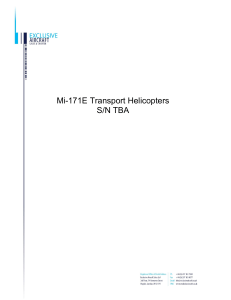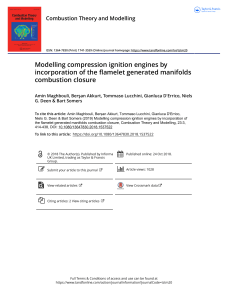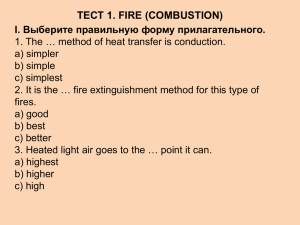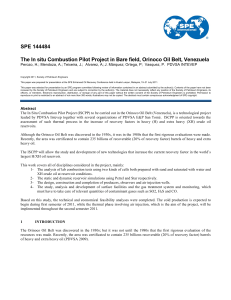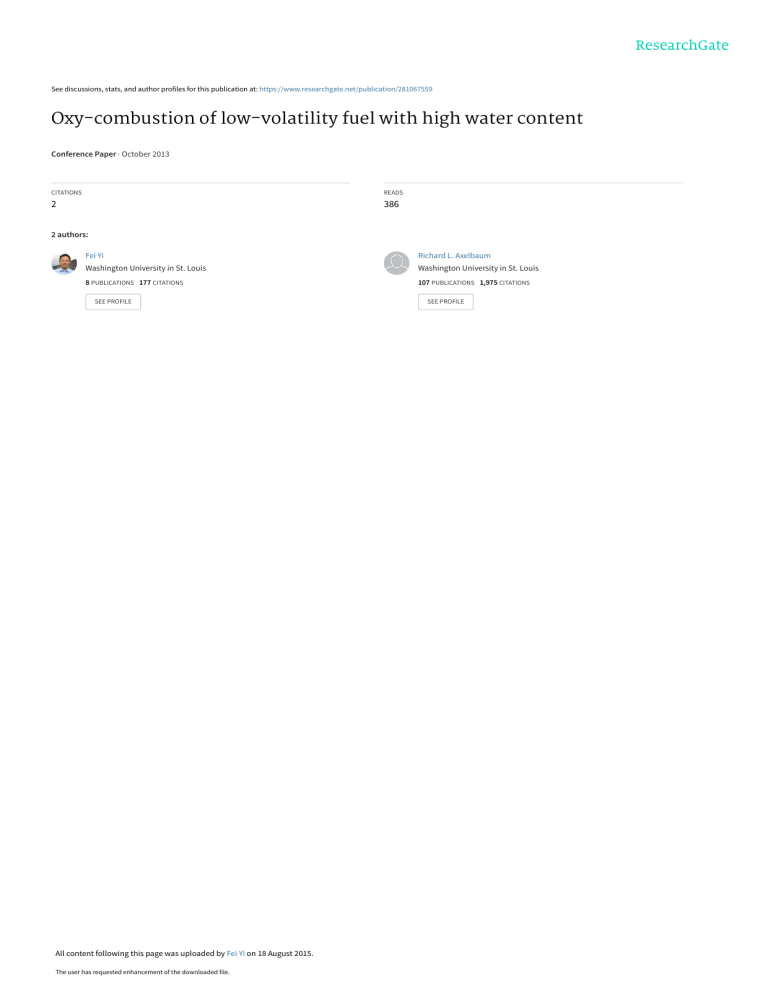
See discussions, stats, and author profiles for this publication at: https://www.researchgate.net/publication/281067559 Oxy-combustion of low-volatility fuel with high water content Conference Paper · October 2013 CITATIONS READS 2 386 2 authors: Fei Yi Richard L. Axelbaum Washington University in St. Louis Washington University in St. Louis 8 PUBLICATIONS 177 CITATIONS 107 PUBLICATIONS 1,975 CITATIONS SEE PROFILE All content following this page was uploaded by Fei Yi on 18 August 2015. The user has requested enhancement of the downloaded file. SEE PROFILE 2013 Eastern States Section Meeting of the Combustion Institute Oxy-combustion of low-volatility fuel with high water content Fei Yi, Richard L. Axelbaum Department of Energy, Environmental & Chemical Engineering, Washington University in St. Louis, St. Louis, USA Abstract Fundamental study on oxy-combustion of high water content fuels is continued from our previous work. In this study, the investigation focuses on low-volatility fuel. Glycerol is chosen as the candidate. It is found that self-sustained flame can only be obtained for glycerol solution with concentrations as high as 60 wt%, even burned in pure oxygen. However, the flame is lifted away from the nozzle. t-Butanol and ethanol, as high-volatility fuels, were added into low-concentration glycerol solutions to assist the combustion. Experiments showed that attached flame can be obtained by burning the mixture containing 8.3 wt% t-butanol, 30 wt% glycerol and 61.7 wt% water (B8.3/G30) or 10 wt% ethanol, 30 wt% glycerol and 60 wt% water (E10/G30) under oxy-fired condition. The flame stability for B8.3/G30 and E10/G30 was characterized under 100% and 85% swirl flow conditions. Temperature measurements were conducted for stable flames under 4 different conditions and temperature contours were generated. For stable flames, a hot zone exists in near burner region, which provides heat to robustly vaporize the high water content fuels in order to stabilize the flame.. activity coefficients of glycerol and water in glycerol/water mixture at 90 ℃ are shown in Fig. 1. The calculation is accomplished by the UNIversal Functional Activity Coefficient (UNIFAC) method [6]. The activity coefficient of glycerol does increases with decreasing glycerol concentration, as with ethanol and t-butanol. However, the value is only slightly greater than 1, which means the activity coefficient will not play an important role as it does for ethanol and t-butanol. Preferential vaporization of glycerol over water will not occur. On the contrary, water will preferentially vaporize over glycerol. 1. Introduction In our previous studies, in order to increase the overall energy efficiency of high water content fuels with carbon capture, we proposed direct oxy-combustion and demonstrated its feasibility [1, 2]. So far, we have investigated the oxy-combustion of high-volatility fuels with high water content, including ethanol, 1-propanol and t-butanol. However, low-volatility fuels with high water content are abundant in nature. In our previous paper, fine coal and microalgae are mentioned as examples of high water content fuels [2]. Typically, coal contains water, volatile, char and ash. The devolatilization temperature for coal is normally above 300 ℃ [3]. So coal slurry made of coal fine will not have preferential vaporization of fuel. Proximate analysis of microalgae shows it is composed of water, ash, lipid, protein and carbohydrate [4]. Apparently, the combustible mass in microalgae has lower volatility than water. It is worthwhile to study the oxy-combustion characteristics of low-volatility fuels with high water content. To study the combustion characteristics of a low volatility fuel heavily diluted in water, a convenient fuel is preferred. Glycerol, which is chosen as the fuel, completely dissolves in water, making the mixture easily to be prepared and atomized. The boiling point of glycerol is 290 ℃ [5] and its vapor pressure is low even at 100 ℃, which is the boiling point of water. The Fig. 1. Activity coefficients of glycerol and water in glycerol/water mixture at 90 ℃. 2. Experimental The experimental setup is shown in Fig. 2. The 1 2013 Eastern States Section Meeting of the Combustion Institute system was upgraded from the one in previous study [2] by increasing the inner diameter of the chamber from 42 mm to 64 mm. Due to the expansion, the recirculation in near burner zone is stronger than that in previous setup [7]. From previous study [2], the recirculation is very critical for combustion of high water content fuels. Increasing the inner diameter also avoids the impingement of droplets on the inner wall. The main oxidizer stream was split into an axial flow and a swirl flow, and the proportion of each can be readily controlled. Thus, the swirl intensity is adjusted. The chamber was made of quartz and no insulation was applied. The spray nozzle used here is Danfoss 0.50 45º AH nozzle, which generates hollow spray. In each experiment, the pressure drop between the fuel tank and the nozzle was maintained at 6.1 atm to ensure that the fuel flow rate was held constant at 0.47 g/s. Flame stability was characterized by the blow-off limit as in our previous study [2]. To characterize the flame structure, gas-phase mean temperatures were measured using a type B thermocouple traversed through the centerline of the chamber. The junction bead had a diameter of approximate 0.4 mm. The bead was coated with BeO/Y2O3. Reported temperatures were the measured values without correction for radiation loss. The contours were generated by temperatures measured at about 800 positions. The heat and radicals are circulated back to assist combustion reactions. For spray combustion, the fuel jet enters this IRZ and vaporizes into gas phase. If the gas mixture in the IRZ is flammable, it is ignited. Otherwise, a flame cannot be maintained [7]. In our previous studies [1, 2], a fuel with a high volatility relative to water was used. When the jet entering the IRZ, fuel preferentially vaporizes over water, causing the relative fuel mass fraction in the near-burner zone to be higher than that in the droplets. That is why very low concentration fuel solutions can be easily ignited. In this work, glycerol, a fuel with a low volatility relative to water is investigated. Since water, instead of fuel, will be preferentially released in the IRZ, solutions with low fuel concentrations may not be ignitable. In our previous study [1] we found that a stable flame can easily be ignited with 25 wt% ethanol in pure oxygen. For a 41.3 wt% glycerol solution, which has the same energy content as 25 wt% ethanol we were not able to ignite a flame in our system. When the system is changed from preferential vaporization of fuel to preferential vaporization of water, the fuel concentration needs to be increased to generate a combustible vapor around the spray. For a 50.0 wt% glycerol solution, a flame can be stabilized provided that a pilot flame is left on. For 60.0 wt% glycerol solution, a self-sustained flame can be obtained. However, the flame is lifted from the nozzle. The adiabatic temperatures (Tad) for glycerol solutions under stoichiometric conditions with O2 are listed in Table 1. Unlike the ethanol solution, which can maintain a stable flame even when the T ad is as low as about 700 ℃, the glycerol solution needs a much higher Tad to maintain a flame. As the glycerol concentration goes up, the viscosity increases, which means the operating pressure for the nozzle has to be increased accordingly. The minimum operating pressures for the nozzle used here are listed in Table 1. Table 1. Operation pressures and adiabatic temperatures for glycerol solutions. Glycerol Operating pressure Tad in O2 for φ = 1 wt% (atm) (℃) Fig. 2. Experimental setup for spray combustion stability 41.3 6.1 1816 studies. 50.0 7.5 2197 3. Results and discussions 3.1 Flame stability In a swirl-stabilized burner, an inner recirculation zone (IRZ) is generated due to the toroidal vortex [8, 9]. 60.0 8.2 2602 To quantitatively analyze the vaporization of a droplet containing glycerol and water, a calculation was conducted for both distillation limit and diffusion limit 2 2013 Eastern States Section Meeting of the Combustion Institute modes, following the model reported in [1]. The ambient temperature of 700 ℃ was assumed and no enhancement for mass transfer due to convection was considered. Fig. 3 illustrated the temporal variation of percentage of each component left in a single droplet containing 50 wt% glycerol on a dimensionless time scale. Due to the volatility difference between glycerol and water, water preferentially vaporizes from the droplet over glycerol under both assumptions. Additionally, almost no glycerol vaporizes initially. The slow release of glycerol is consistent with the experimental results. flame stability in this study, too. An attached and stable flame can also be obtained by adding small amount of ethanol. To make comparison to B8.3/G30 case, mixture E10/G30, containing 10 wt% ethanol, 30 wt% glycerol and 60 wt% water was tested. For both B8.3/G30 and E10/G30, complete combustion of the additive (t-butanol or ethanol) in a unit mass of the mixture releases the same heat. The flame stability results are shown as below. The flame stability map under 100% swirl flow condition for B8.3/G30 and E10/G30 is shown in Fig. 4. The curves are blow-off limit curves. The stars in Fig. 4 indicate the global stoichiometry for the fuel and oxidizer flow rates. As the total oxidizer flow rate (Q) increases the global stoichiometry on the curve goes from fuel rich to fuel lean. The feature of the blow-off limit curves is similar to that from our previous studies [1]. As the Q increases, the blow-off limit first decreases dramatically, and then flattens out. Arai et al. found that, for the same swirl number, the residence time under flame situation increases with the Q and then decreases slowly after reaching the maximum value [11]. In our system, with increase of the Q, the residence time increases, which provide longer time to vaporize the droplets. Additionally, as the Q goes up, the IRZ grows larger, which circulates more heat to vaporize the fuels. Even though the residence time and volume of IRZ increases, which is favorable for flame stability, the flame blows off when the flammability limit reaches. Thus, the blow-off limit curve flattens out as the total oxidizer further increases. Since the residence time decreases with Q after it reaches Fig. 3. Temporal variation of percentage of each component left in a single droplet, where r is the droplet radius. Our previous study [2] found that t-butanol shows extremely strong preferential vaporization over water during the droplet vaporization. It is expected that adding small amount of t-butanol in low concentration glycerol solution can assist the vaporization and combustion of glycerol. t-Butanol first vaporizes from the droplets and reacts with oxygen. The heat released due to the reaction can accelerate the gasification of glycerol, which enhance the flame stability. The idea of adding a small amount of a volatile component to enhance the ignitability is also used in experiments for regular fuels [10]. In this study, a mixture, denoted as B8.3/G30, contained 8.3 wt% t-butanol, 30 wt% glycerol and 61.7 wt% water was tested in the swirl-stabilized burner. For B8.3/G30, the heat released by complete combustion of t-butanol is greater than the heat required to vaporize the rest glycerol and water. It turned out that an attached and stable flame can be easily obtained under oxy-fire condition in our system. Further, it is known that ethanol also shows preferential vaporization over water [1], but it is not as strong as t-butanol. Ethanol was added as an additive to test the Fig. 4. Stability map under 100% swirl flow condition. The stars indicate conditions of global stoichiometry for the fuel and oxidizer flow rates. 3 2013 Eastern States Section Meeting of the Combustion Institute maximum, the E10/G30 blow-off curve slightly increases with Q when Q is above 25 lpm. On the contrary, the B8.3/G30 blow-off curve is still flat when Q is above 25 lpm. The preferential vaporization of t-butanol is faster than ethanol, so slight decrease in the residence time does not influence negatively on flame stability for B8.3/G30. The flame stability map under 85% swirl flow condition for B8.3/G30 and E10/G30 is shown in Fig. 5. When 15% flow is introduced from axial flow, the flame is lifted under some conditions. And the lift-off limit is also shown in Fig. 5. For both cases, when operating under conditions below the lift-off limit curve and above blow-off limit curve, the flame is lifted. The lifted flame fluctuates badly when the oxygen concentration reduced. For B8.3/G30, the flame doesn’t lift off before it blew off if Q is above 19 lpm. From Fig. 5, B8.3/G30 case still maintains the attached flame under the conditions which the flame for E10/G30 already lifts off. In the low Q region, the blow-off limit for B8.3/G30 is much lower than E10/G30. However, the blow-off limit curves approximately overlap on each other in high Q region. Apparently, the advantage of preferential vaporization of t-butanol is more obvious when the residence time is limited. Comparing to 100% swirl case, the residence time under 85% swirl is shorter under the same Q. t-Butanol vaporizes faster than ethanol, so the IRZ can accumulates more volatile fuel vapor. With heat release from the combustion of t-butanol in the IRZ, glycerol's vaporization is accelerated, which provides more fuel in the IRZ. Therefore, an attached flame can be maintained for B8.3/G30, while the flame for E10/G30 is either blown off or lifted off under the same condition. 3.2 Flame characteristics The attached and stable flames, based on the flame stability map shown in Fig. 4 and Fig. 5, were chosen to run the temperature measurements. The running conditions are listed in Table 2. The Q for all the four cases was 22.5 lpm. The results are presented as temperature contours along with pictures shown in Fig. 6. The contours have the same temperature scale. As shown in Fig. 6, there is a hot core at the base of the hollow spray cone for the four tested flames. For all the four cases, the peak temperature was measured in the center region close to the nozzle's orifice. The IRZ enhances the mixing of the high concentration fuel and oxidizer in close nozzle region, leading to the peak temperature. Because of the reaction occurring in IRZ, a fair amount of heat is released at the spray base, accelerating the vaporization of droplets. Thus, an attached flame is formed. Table 2. Running conditions for temperature measurements Run No. Fuel a E10/G30 b c d Oxidizer Swirl% 100% O2 85% E10/G30 100% O2 100% E10/G30 80% O2/20%CO2 100% B8.3/G30 100% O2 85% The running condition for Case a is close to the lift-off limit according to the stability map in Fig. 5. On the contrary, the flame for Case b is very stable according to Fig. 4. Comparing the contours and pictures between Case a and b, it is obvious that the flame shrank in x-direction after the proportion of the axial flow increased from 0 to 15%. The peak temperature in Case a is lower than that in Case b. In a swirl-stabilized burner, the volume of IRZ becomes wider and longer with increase of swirl intensity [7]. Because 15% of the oxidizer is introduced from the axial flow, the recirculation is not strong as 100% swirl condition, causing the IRZ becomes narrower and shorter. That is why the flame shrank in x-direction. The temperature in the outer region of the spray for Case a is lower than that for Case b. Apparently, the heat circulated in IRZ for Case a is less than that for Case b. Comparing Case b and c, it is found that flame temperature reduced because the O2 was diluted from 100% down to 80%. From the pictures, the brightness of the flame in IRZ for Case c is lower than that for Case b. The reaction zone for Case c expanded in x-direction relative to Case b, which is evident in both temperature contour and picture. As the O2 Fig. 5. Stability map under 85% swirl flow condition. The stars indicate conditions of global stoichiometry for the fuel and oxidizer flow rates. 4 2013 Eastern States Section Meeting of the Combustion Institute concentration decreases, the reaction zone grows larger. The spray hollow cone is also clearly identified in the temperature contour for Case c, which is not obvious in other cases. In the Case d, the oxidizer flow is the same as the Case a. From the contours, they have similar flame shape, which is narrower compared to Case b and c running at higher swirl intensity condition. The peak temperature for Case d is higher than that of Case a. This is because t-butanol is released faster than ethanol, resulting higher fuel concentration in IRZ. More concentrated fuel vapor leads to the higher temperature. From Fig. 5, it is obvious that Case d is not that easy to be lifted as Case a, when the O2 concentration reduces. Because more volatile fuel is consumed in IRZ for Case d, more heat is released, which accelerates the vaporization of the fuel in water. Thus, generating a hot IRZ is critical to maintain an attached flame when the swirl intensity reduces. 4. Conclusion In this study, glycerol is chosen to study the oxy-combustion characteristics of low-volatility fuel with high water content. It is found that self-sustained flame can only be obtained for glycerol solution with concentration as high as 60 wt%, when it is burned in pure oxygen. However, the flame is lifted far away from the nozzle. To obtain stable flame for low glycerol concentration solution, t-butanol or ethanol was added as additive. Experiment showed that attached flame can be obtained by burning the mixture B8.3/G30 or E10/G30 under oxy-fired condition. The flame stability for B8.3/G30 and E10/G30 was characterized under both 100% and 85% swirl flow conditions. Under 100% swirl flow condition, the blow-off limits are approximately the same for both cases. Under 85% swirl flow condition, the blow-off limits for B8.3/G30 are much lower in the low-total-flow-rate region. Additionally, the lift-off limits for B8.3/G30 are shifted to the left compared to E10/G30, which means the flame stability for B8.3/G30 is better. To study the flame structure, contours of temperature across the chamber’s centerline were obtained for four attached flames. It is found the flame becomes narrower as the swirl intensity decreases. A high temperature zone in the IRZ is formed for the four flames. This hot zone is critical to provide heat to vaporize the glycerol in near burner region, so that flame can be attached on the nozzle. Acknowledgement This work was supported by the NSF (1337008) and the Consortium for Clean Coal Utilization at Washington University in St. Louis. References 1. Yi, F., Axelbaum, R.L., Stability of spray combustion for water/alcohols mixtures in oxygen-enriched air. Proceedings of the Combustion Institute, 2013. 34: 1697-1704. 2. Yi, F., Axelbaum, R.L., Utilizing preferential vaporization to enhance the stability of spray combustion for high water content fuels. in preparation. 3. Tomeczek, J., Coal Combustion. 1994, Krieger Publishing Company. 4. Tokusoglu, O., Unal, M.K., Biomass nutrient profiles of three microalgae: Spirulina platensis, Chlorella vulgaris, and Isochrisis galbana. Journal of Food Science, 2003. 68(4): 1144-1148. 5. Perry, R.H., Green, D.W., Perry's Chemical Engineers' Handbook (7th Edition). 1997, McGraw-Hill. 6. Poling, B.E., Prausnitz, J.M., O’Connell, J.P., The Properties of Gases and Liquids. 2001, McGraw-Hill Professional. 7. Gupta, A.K., Lilley, D.G., Syred, N., Swirl flows. Energy and engineering science series. 1984, Abacus Press. 8. Chen, R.H., Driscoll, J.F., Kelly, J., Namazian, M., Schefer, R.W., A Comparison of Bluff-Body and Swirl-Stabilized Flames. Combustion Science and Technology, 1990. 71(4-6): 197-217. 9. Sequera, D., Agrawal, A.K., Spear, S.K., Daly, D.T., Combustion performance of liquid biofuels in a swirl-stabilized burner. Journal of Engineering for Gas Turbines and Power-Transactions of the Asme, 2008. 130(3). 10. Aggarwal, S.K., A review of spray ignition phenomena: Present status and future research. Progress in Energy and Combustion Science, 1998. 24(6): 565-600. 11. Arai, M., Nomura, T., Hiroyasu, H., Residence time measurement in a swirl type combustor with helium tracer. Transactions of the Japan Society of Mechanical Engineers Series B, 1987. 53(492): 2619-2625. 5 2013 Eastern States Section Meeting of the Combustion Institute (a) (b) (c) (d) Fig. 6. Temperature contours and according flame pictures. 6 View publication stats

